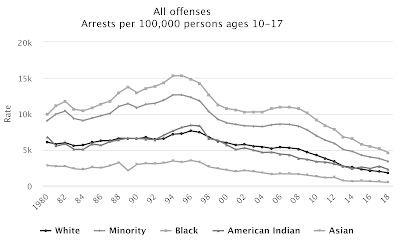Children In The Justice System
Juveniles that have turmoil or hardships within their homes growing up are certainly more susceptible to police contact and entering the juvenile justice system at some point in their adolescence. If not the justice system then into a human services department for one reason or another whether that is to obtain some help or being court ordered into a program.
While these numbers have seen a decrease in overall rates, there is a definite inequality between black and white juveniles. In an article by NPR, it was found that the Justice Dept. has shown a 54% decrease in overall incarceration rates of juveniles. Citing the official stats for 2015, for every 100,000 youth, 152 were in custody, which is a dramatic drop from 2001 when there were 334 incarcerated for every 100,000.
However, these numbers seem to be somewhat skewed as The Sentencing project indicates that in 2001 black youths work 4 times as likely to be imprisoned as their white counterparts were, but in 2015 that number had risen to a ratio of 5-1, signifying an increased disparity from 2001-15.
This issue needs to be addressed and brought to light. Racial inequality is a major factor in the arrest and incarceration of other than white citizens, even as the rate declines.
*Works Cited
“Department of Justice Statisitcs.” Juvenile Arrest Rate Trends, 2018, www.ojjdp.gov/ojstatbb/crime/JAR_Display.asp?ID=qa05219&selOffenses=34.
Olivares, Jose. “Fewer Youths Incarcerated, But Gap Between Blacks And Whites Worsens.” NPR, NPR, 27 Sept. 2017, www.npr.org/2017/09/27/551864016/fewer-youths-incarcerated-but-gap-between-blacks-and-whites-worsens.
Roth, Kenneth. “World Report 2019: Rights Trends in the United States.” Human Rights Watch, 17 Jan. 2019, www.hrw.org/world-report/2019/country-chapters/united-states.
Written by Jacob Buswell
Written by Jacob Buswell



Comments
Post a Comment
Let your knowledge, ideas, and innovation be heard. Tell us what you think and know about this topic.